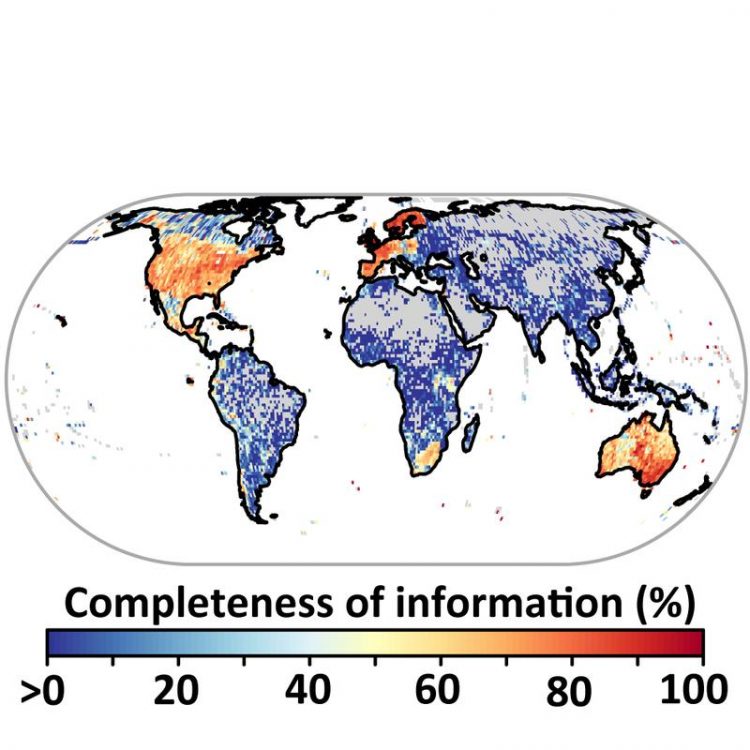International research team determines knowledge gaps on species occurences

Gaps in information on species distribution: Warmer colors indicate areas of the world where most species are represented with data. Grey areas have no data. Photo: University of Göttingen
Tiger, harpy eagle, giant salamander: Emerging economies from Brazil to China are home to some of the most fascinating and threatened animals on earth. But despite these biological treasures, very few biological records are accessible for those countries.
This was shown by the most comprehensive survey of global species distribution data to date, just published in the journal Nature Communications by an international research team from the University of Göttingen in Germany and the US-American University of Florida and Yale University.
The scientists investigated millions of occurrence records of all known species of mammals, birds and amphibians, most of which come from natural history museums that make information on the locations of their animal collections available. The researchers calculated how well those data represent species in different parts of the world.
“Until now it was thought that the largest data gaps were in tropical developing countries, which are rich in biodiversity but often lack the resources to study it,” the first author of the study, Dr. Carsten Meyer from the University of Göttingen, explains. “Accordingly, we were surprised to find the largest knowledge gaps in relatively wealthy emerging economies.“
The team investigated the reasons for regional differences in the state of knowledge. The decisive factors were the spatial proximity to research institutions, the willingness of countries to share data internationally, and the availability of research funds.
“If we wanted to improve global knowledge effectively, it would be particularly helpful to improve the scientific cooperation between industrialized and emerging economies,” Dr. Meyer says. “The latter countries often hold tremendous amounts of data, but do not yet make them available internationally.”
“Free and easy access to exact data on the occurrences of plants and animals is crucial for answering central questions in ecology and evolution“, the co-leading author of the study, Professor Holger Kreft from the University of Göttingen, explains.
“For instance, such data can be used to estimate how species worldwide will react to future climate change. Such data also build the scientific foundations for important decisions in environmental policy, for instance, where to establish protected areas or whether to list certain species as endangered.”
The scientists hope that the new findings will contribute to a better international coordination of efforts to collect and provide biodiversity data. Funding and expertise for such activities exists primarily in industrialized nations, which are often comparatively species-poor and already well-studied.
“Some of these resources may be better applied in countries that lack the necessary expertise and modern technologies. This could be done via direct partnerships between research institutions of industrialized and developing countries,“ Dr. Meyer says.
According to the study, even amateur naturalists can make important contributions to research on species distribution, and thus directly assist their protection. Smartphone apps like eBird, iNaturalist or Map of Life allow nature lovers to share their observation of animals online with scientists across the world.
Original publication: Carsten Meyer et al. Global priorities for an effective information basis of biodiversity distributions. Nature Communications 2015. Doi: 10.1038/NCOMMS9221.
Contact:
Prof. Dr. Holger Kreft
Georg-August-Universität Göttingen
Free Floater Research Group „Biodiversity, Macroecology and Conservation Biogeography“
Büsgenweg 1, 37077 Göttingen, Germany
Phone +49 551 39-10727
Email: hkreft@uni-goettingen.de
Dr. Carsten Meyer
Georg-August-Universität Göttingen
Free Floater Research Group „Biodiversity, Macroecology and Conservation Biogeography“
Büsgenweg 1, 37077 Göttingen, Germany
Phone +49 551 39-10727
Email: cmeyer2@uni-goettingen.de
Media Contact
All latest news from the category: Earth Sciences
Earth Sciences (also referred to as Geosciences), which deals with basic issues surrounding our planet, plays a vital role in the area of energy and raw materials supply.
Earth Sciences comprises subjects such as geology, geography, geological informatics, paleontology, mineralogy, petrography, crystallography, geophysics, geodesy, glaciology, cartography, photogrammetry, meteorology and seismology, early-warning systems, earthquake research and polar research.
Newest articles

First-of-its-kind study uses remote sensing to monitor plastic debris in rivers and lakes
Remote sensing creates a cost-effective solution to monitoring plastic pollution. A first-of-its-kind study from researchers at the University of Minnesota Twin Cities shows how remote sensing can help monitor and…

Laser-based artificial neuron mimics nerve cell functions at lightning speed
With a processing speed a billion times faster than nature, chip-based laser neuron could help advance AI tasks such as pattern recognition and sequence prediction. Researchers have developed a laser-based…

Optimising the processing of plastic waste
Just one look in the yellow bin reveals a colourful jumble of different types of plastic. However, the purer and more uniform plastic waste is, the easier it is to…



